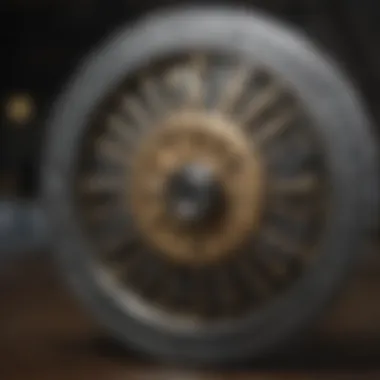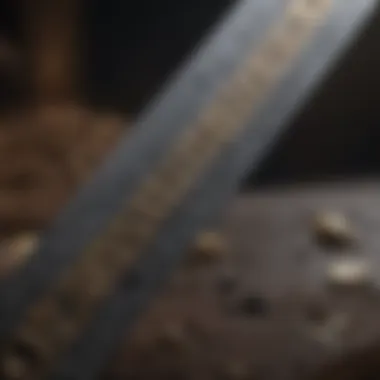Discover the Intricate World of Jeweler Saw Blade Sizes for Precision Cutting


Rock and Fossil Identification
Introduction
In the realm of jewelry making, precision is paramount, and the choice of jeweler saw blade sizes plays a pivotal role in achieving immaculate cuts. This section delves into the essential aspects of blade sizes, unveiling the intricate details that contribute to the flawless creation of intricate designs. Whether you are a novice venturing into the world of jewelry crafting or an experienced artisan seeking to enhance your skills, understanding the nuances of jeweler saw blade sizes is key to elevating your craft.
Understanding Jeweler Saw Blades
Overview of Jeweler Saw Blades
The overview of jeweler saw blades sets the foundation for comprehending the intricate tools essential for precise cutting. A deep dive into the structure and composition of these blades reveals the finesse required for manipulating them effectively. Their thin construction and intricate teeth patterns are tailored to maneuver through delicate materials with finesse, making them indispensable in the realm of jewelry making.
Importance of Choosing the Right Blade Size
Selecting the appropriate blade size is akin to choosing the right brush for a painter; it significantly impacts the outcome of the final piece. The importance of selecting the correct blade size lies in its ability to cater to the specific intricacies of the jewelry design. Opting for the right blade size ensures smooth cutting operations, precise detailing, and overall efficiency in the crafting process. However, an erroneous choice might lead to irregular cuts, material wastage, and compromised precision.
Overview of Blade Sizes
Common Blade Sizes
Common blade sizes encompass a range of options tailored to different cutting requirements, ensuring versatility in jewelry making. Understanding the variations in blade sizes allows artisans to select the most suitable option for their specific projects. Each common blade size offers distinct advantages, catering to various materials and design intricacies, enabling artisans to achieve remarkable precision in their craft.
Variations in Teeth Per Inch (TPI)
The variations in teeth per inch (TPI) within jeweler saw blades provide artisans with options to customize their cutting approach based on the intricacy of their designs. Higher TPI blades offer finer cuts suited for delicate materials, while lower TPI blades excel in rapid material removal. Finding the ideal TPI ensures optimal cutting performance and enhances the artisan's ability to execute intricate designs with precision.
Relationship Between Blade Sizes and Materials
The relationship between blade sizes and materials is a critical factor in the jewelry making process. Different materials require specific blade sizes to ensure efficient cutting operations and impeccable results. Adapting the blade size to the material thickness optimizes cutting effectiveness, prevents breakage, and enhances overall precision. Understanding this relationship empowers artisans to navigate varying material compositions with ease, resulting in flawless jewelry creations.


Factors Influencing Blade Selection
Material of the Workpiece
The choice of blade depends significantly on the material of the workpiece, as different materials present unique challenges and requirements for cutting. Selecting the appropriate blade tailored to the workpiece material ensures smooth cutting operations without causing damage to the material or the blade itself. This consideration enhances efficiency, prolongs blade lifespan, and contributes to the overall quality of the crafted piece.
Precision of Cuts Required
The level of precision required in a jewelry design directly influences the selection of the blade size. Intricate designs demand finer blade sizes to navigate complex patterns and create detailed contours with utmost accuracy. Conversely, projects requiring straight cuts benefit from medium to coarse blade sizes, facilitating efficient material removal while maintaining precision. Adapting the blade size to the precision level needed enhances the artisan's control over the cutting process, resulting in flawlessly executed designs.
Types of Cuts (Intricate Designs vs. Straight Cuts)
The type of cut, whether intricate designs or straight cuts, dictates the selection of the blade size in jewelry crafting. Fine blades excel in intricate designs, allowing artisans to maneuver through detailed patterns with finesse and delicacy. In contrast, medium to coarse blades suit straight cuts, providing efficient material removal without compromising precision. Choosing the appropriate blade size based on the type of cut enhances the artisan's ability to achieve desired outcomes, be it intricate detailing or streamlined designs.
Types of Jeweler Saw Blade Sizes
In the realm of jeweler saw blade sizes, understanding the nuances of the various types plays a crucial role in the precision and intricacy of jewelry making. Choosing the right blade size is paramount for achieving desired results in cutting intricate designs. The types of jeweler saw blade sizes encompass a range from fine to coarse, each catering to specific needs and materials. Fine blades are adept at delicately intricate designs, medium blades strike a balance between versatility and precision, while coarse blades excel at cutting through thicker materials efficiently.
Fine Blades (/ to )
Applications in Delicate Intricate Designs
Fine blades in the range of 8/0 to 8 offer unparalleled precision when working on intricate designs in jewelry making. Their ultra-thin profile allows jewelers to navigate detailed patterns with utmost accuracy, ensuring clean cuts and minimal material wastage. These blades are deemed essential for ornamentation and delicate embellishments, providing craftsmen with the finesse required for high-quality jewelry production. However, their delicate nature may require careful handling to prevent breakage during use.
Suitability for Thin Materials
The thinness of fine blades makes them exceptionally suitable for cutting through thin materials commonly used in jewelry making. From thin metals to delicate gemstones, these blades offer a smooth cutting experience without causing damage or distortion to the material. Their precision in maneuvering through intricate shapes and curves makes them a go-to choice for craftsmen aiming for intricate detailing in their creations. While ideal for thin materials, fine blades may lack the robustness needed for thick or heavy-duty cutting tasks.
Medium Blades (/ to )
Balancing Versatility and Precision


Medium blades ranging from 2/0 to 6 strike a fine balance between versatility and precision in jewelry making. They serve as reliable workhorses capable of handling a wide array of cutting tasks, from intricate designs to general jewelry making. Their moderate thickness allows for controlled cuts without compromising on the intricate detailing required in jewelry fabrication. Craftsmen find medium blades to be versatile tools that cater to the divergent needs of jewelry projects, offering a blend of accuracy and adaptability.
Ideal for General Jewelry Making
Medium blades are the optimal choice for general jewelry making due to their ability to deliver consistent and precise cuts across various materials. Whether crafting simple designs or intricate patterns, these blades provide the necessary sharpness and control required for shaping metals and gemstones. Their versatility makes them a staple in jewelry workshops, where craftsmen rely on their efficiency to bring their creative visions to life. However, while ideal for general applications, medium blades may lack the finesse needed for highly delicate or intricate designs.
Coarse Blades ( to )
Efficient Cutting of Thicker Materials
Coarse blades falling in the range of 0 to 6 excel in efficiently cutting through thicker materials encountered in jewelry making. Their robust teeth and thicker profile make them ideal for slicing through metals, wood, or other dense materials with ease. Craftsmen opt for coarse blades when rapid material removal is paramount, as these blades can tackle substantial thicknesses without compromising cutting speed. However, their coarse nature may result in rougher cuts, necessitating additional refinements for achieving a polished finish.
Utilization in Rapid Material Removal
In scenarios requiring swift material removal, coarse blades serve as the go-to option for jewelers aiming to expedite their cutting processes. Their aggressive tooth configuration and sturdier build facilitate quick and efficient removal of excess material, saving time and effort during production. Craftsmen appreciate the speed and power offered by coarse blades when dealing with bulky metals or challenging materials that demand rapid processing. Despite their effectiveness in material removal, coarse blades may leave rough edges that necessitate further sanding or finishing for a refined end product.
Choosing the Right Blade Size
In the realm of jewelry making, the selection of the right blade size holds utmost importance. When delving into the intricacies of jeweler saw blade sizes, choosing the appropriate size becomes critical to achieving precise cutting results. The blade size directly impacts the ability to execute intricate designs with accuracy and finesse. Furthermore, selecting the correct blade size is essential for optimizing the cutting process and enhancing overall efficiency in jewelry fabrication. Demonstrating a keen understanding of the material being worked on and the specific tasks at hand, the right blade size can greatly influence the final outcome of the jewelry piece. Whether it's delicate filigree work or cutting through thicker materials, the blade size plays a pivotal role in the success of the jewelry-making process.
Matching Blade Size to Material Thickness
Selecting Appropriate TPI
Selecting the appropriate Teeth Per Inch (TPI) for jeweler saw blades is a crucial factor when matching blade size to material thickness. The TPI refers to the number of teeth on the blade per inch, and it directly affects the cutting speed and precision. In this context, choosing the right TPI is paramount for achieving optimal cutting performance. A higher TPI is ideal for intricate cuts on thin materials, providing finer details and smoother edges. Conversely, a lower TPI is suitable for cutting through thicker materials where rapid material removal is required. Understanding the correlation between TPI and material thickness enables jewelers to make informed decisions when selecting the appropriate blade size for their specific projects.
Considering Blade Flexibility
The flexibility of jeweler saw blades is another critical aspect to consider when matching blade size to material thickness. Blade flexibility determines the blade's ability to bend and maneuver through different contours and angles during cutting. Opting for a blade with the right degree of flexibility ensures smooth and precise cuts, especially when working on intricate designs or curves. Blades with higher flexibility offer greater maneuverability for complex cuts, while stiffer blades are preferred for straight cuts on denser materials. By considering blade flexibility in conjunction with material thickness, jewelers can achieve optimal cutting results tailored to their unique fabrication requirements.


Best Practices for Working with Jeweler Saw Blades
When delving into the intricate world of jeweler saw blade sizes, understanding the best practices for working with these tools is essential. These best practices play a crucial role in ensuring precise cutting and maintaining the longevity of both the blades and the workpieces. By following these practices, jewelers can elevate the quality of their craftsmanship and achieve intricate designs with precision.
Maintaining Blade Sharpness
Regular Blade Replacement:
Regular blade replacement is a cornerstone practice in working with jeweler saw blades. By frequently replacing blades, jewelers ensure that each cut is clean and precise. This practice not only enhances cutting accuracy but also reduces the risk of blade breakage, which can damage the workpiece. The key characteristic of regular blade replacement is its ability to maintain the sharpness of the blade throughout the cutting process, resulting in consistent and fine cuts. Jewelers opt for regular blade replacement due to its reliability and efficiency in maintaining optimal cutting performance. With regular replacements, jewelers can work on various materials with confidence, knowing that their blades are in top condition.
Proper Storage Techniques:
In addition to regular blade replacement, proper storage techniques are vital for prolonging the lifespan of jeweler saw blades. Storing blades correctly helps prevent corrosion, bending, or other forms of damage that can affect cutting precision. The key characteristic of proper storage techniques is preserving the sharpness and integrity of the blades when not in use. By storing blades in a dry and secure environment, jewelers can protect their investment and ensure that the blades remain in optimal condition for future use. Proper storage techniques are a popular choice among jewelers seeking to extend the life of their blades and maintain cutting efficiency over time.
Techniques for Precise Cutting
Use of Lubricants:
The use of lubricants is a crucial technique for achieving precise cutting with jeweler saw blades. Lubricants reduce friction between the blade and the workpiece, enabling smoother cutting motion and minimizing heat buildup. The key characteristic of using lubricants is their ability to improve cutting efficiency and prevent blade dulling. Jewelers favor the use of lubricants for their ability to enhance overall cutting performance and prolong blade lifespan. By incorporating lubricants into their cutting process, jewelers can achieve cleaner, more accurate cuts on various materials.
Applying Correct Pressure:
Applying the correct pressure while using jeweler saw blades is paramount to achieving precise cuts. The key characteristic of applying correct pressure is maintaining a delicate balance between pushing the blade too hard, which can cause breakage, and applying too little pressure, resulting in ineffective cutting. By mastering the art of applying the right amount of pressure, jewelers can control the cutting process with precision and finesse. Proper pressure application is a popular choice among jewelers seeking to improve cutting accuracy and efficiency in their jewelry-making endeavors.
Conclusion
In delving into the realm of jeweler saw blade sizes, we have uncovered a treasure trove of information essential for precise cutting in jewelry-making. Understanding the nuances of blade sizes is paramount for achieving impeccable craftsmanship and intricate designs. By choosing the right blade size tailored to specific tasks, jewelers can elevate their creations to new heights of accuracy and finesse. The importance of blade size selection cannot be understated, as it directly impacts the quality and precision of cuts in various materials.
Summary of Key Points
Impact of Blade Size on Cutting Accuracy
The impact of blade size on cutting accuracy is a crucial aspect that significantly influences the final outcome of jewelry pieces. Choosing the correct blade size ensures clean and precise cuts, crucial for intricate designs and detailed work. Blade sizes directly affect the ability to maneuver through different materials with precision, making it imperative to select the appropriate size based on the thickness and intricacy of the design. The relationship between blade size and cutting accuracy is symbiotic, with each size catering to specific requirements, thus allowing jewelers to achieve unparalleled precision.
Essential Considerations for Blade Selection
When it comes to the essential considerations for blade selection, factors such as material thickness, intricate design requirements, and cutting precision play pivotal roles in determining the ideal blade size. Understanding the properties of different blade sizes and their compatibility with various materials is essential for achieving desired results. Blade flexibility and teeth per inch (TPI) are also critical elements to consider, as they directly impact cutting efficiency and accuracy. By meticulously evaluating these factors, jewelers can make informed decisions when selecting a blade size that aligns with their specific jewelry-making needs.







